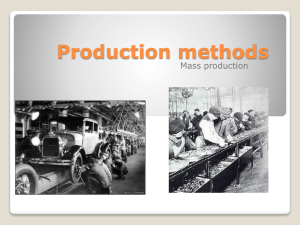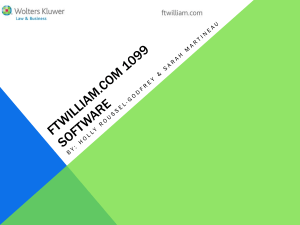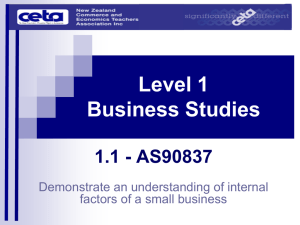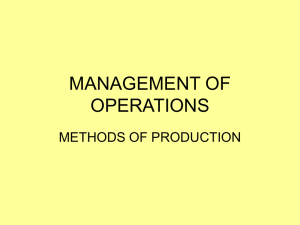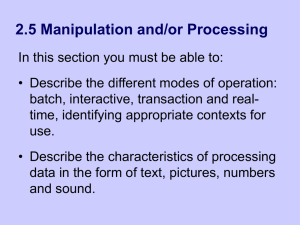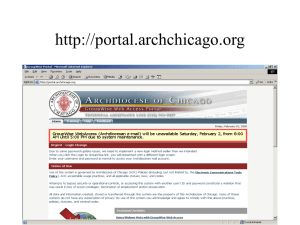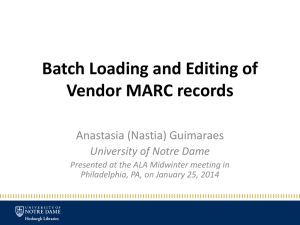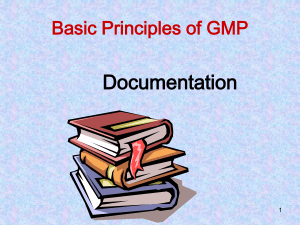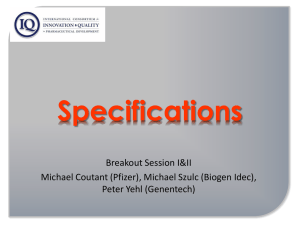Overview - inglasia
advertisement
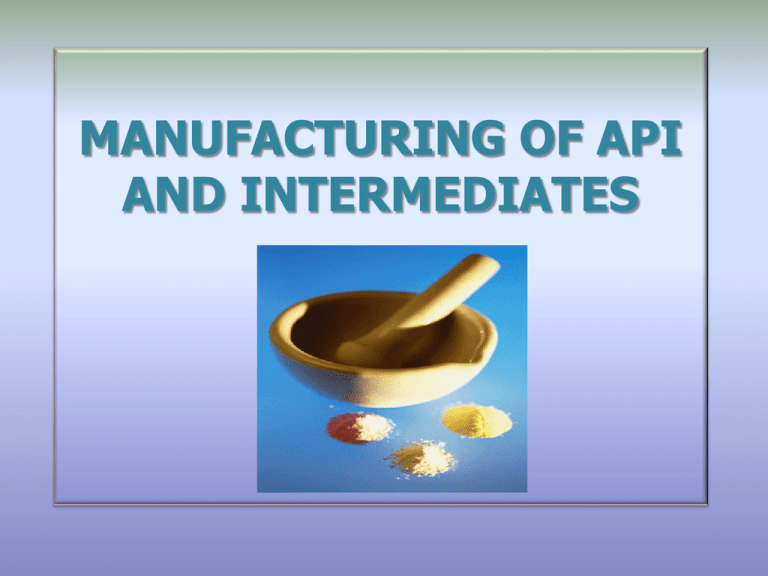
MANUFACTURING OF API AND INTERMEDIATES Overview • • • • Introduction Scope Responsibilities The Requirements General Considerations Prevention of Cross-Contamination Batch Manufacturing Records And the others (13 items) Introduction • Manufacture of active pharmaceutical ingredients (APIs) and intermediates as finished product, must follow well-defined operating principles System and Principles must be well-defined • Manufacture must comply with current Good Manufacturing Practices (GMPs) and with the corresponding registration dossiers GMP Compliance & Regulatory Compliance 2. Scope This presentation applies to all manufacturing sites and subcontractors, who manufacture active pharmaceutical ingredients and intermediates Based on ICH Q7 (EU GMP part II) 3. Responsibilities • Site Management is responsible for ensuring that adequate resources are in place to comply with the regulatory requirements Adequate Resources to be provided • Site Quality Management is responsible for ensuring that there are systems and procedures in place for the manufacturing of APIs and Intermediates Systems and Procedures must be in place. 4. Requirements (1) General Considerations Prevention of Cross-Contamination Computerised Systems Documentation Batch Manufacturing Records Review of Batch Manufacturing Records Manufacturing Process In-process Sampling and Testing Change Control 4. Requirements (2) • • • • • • • • • Analytical, Biological and Microbiological Tests Water Recycling of Recovered Materials and Solvents Reprocessing Reworking Wastewater and Materials Storage 4. 1. General Considerations (1) • Manufacturing operations must be performed and supervised by trained and qualified personnel • Personnel must wear garments and protective clothing suited to the operation performed and taking into Account any specific Health, Safety and Environment (HSE) requirements. 4. 1. General Considerations (2) • Product handling operations such as receipt, quarantining, sampling, storage, labelling, packaging and transfer must be conducted in a way to prevent any risk of crosscontamination and must be described in appropriate procedures Specific requirements for Highly Active Substances. Dedicated and self-contained facilities must be used for these materials, e.g. beta-lactams, hormones, cytotoxics. 4. 1. General Considerations (3) • All equipment, products, and containers must be clearly labelled and identified. Labels must be designed to be securely affixed, legible, and must not fade or deteriorate with time • Connections between piping (lines, flexible tubing, etc) and other manufacturing equipment used to transfer products must be controlled. 4. 1. General Considerations (4) • Only authorised personnel must be allowed to enter in the manufacturing areas. Site personnel must accompany visitors within manufacturing areas • All company personnel and visitors to the site must be under controlled access and exit at all times • Visitors access and exit must be authorised and documented • Visitors must be accompanied by site personnel at all times unless training in GMPs specific to the area is provided and documented. 4. 1. General Considerations (5) • Equipment used to manufacture intermediates and APIs must be qualified and uniquely identified and be part of a preventive maintenance program • Equipment, instrumentation, computerised and/or control systems, facilities and utilities used in conjunction with the above must be qualified, and systems (e.g. water systems and computerised systems) and processes must be validated and maintained in a documented state of control 4. 1. General Considerations (6) • Critical measuring equipment must be in calibration and be part of a calibration program • All equipment and instruments that could have an impact on product quality, safety or efficacy must be tracked and maintained under a calibration and maintenance program • All calibrations and maintenance must be documented and the records of those activities must be archived • Calibration is essential to maintain product quality, personnel and environmental safety during operation. It is an important step for qualification. 4. 1. General Considerations (7) • Starting materials, raw materials and packaging materials used to manufacture intermediates and APIs must meet predetermined specifications as defined in the registration dossiers and be released by the Quality Unit according to site procedures • All specifications developed for APIs and intermediates must contain at a minimum the following attributes: Appearance and/or Description, Identity, Assay, Impurities • Quality Unit must establish a system to release or reject raw materials, intermediates, packaging and labelling materials (ICH Q7A, under 2.2) 4. 2. Prevention of CrossContamination (1) • Measures must be taken during manufacture to prevent/minimise any contamination risk specifically when manufacturing areas are not dedicated to a single product • Air filtration equipment and environmental zones of the finishing rooms must be subject to the requirements of the Directive “Environmental Zoning & Air Handling Systems” • Prevention of contamination. Cleaning of non-dedicated equipment used for the final steps must be validated • Environmental Zoning & Air Handling System requirements for the final steps: drying, milling, filling. 4. 2. Prevention of CrossContamination (2) • Different batches of product or product in different phases must not be loaded or unloaded simultaneously in the same area/room • Rooms in which packaging and labelling operations are performed must be inspected immediately before use in order to ensure that all non-relevant packaging components have been removed. This operation must be reported in the batch record. (ICH Q7A, 9.44) • If operations on different products are carried out simultaneously or consecutively in the same room, the operations must be segregated and controlled. 4. 3. Computerised Systems • Any computerised system which may have an impact of product quality or which deals with any GMP related data must be validated • Good Practices for Computerised Systems • Computerised Systems Validation • The scope and extend of the validation activities must be commensurate with the GxP risk and complexity of the system • Validation must be based on a documented User Requirement Specification. 4. 4. Documentation • All documents related to the manufacture of intermediates and APIs (e.g. process description, batch manufacturing records), must be prepared, checked, approved and issued following written procedures. ICH Q7, Chapter 6: Documentation and Records 4. 5. Batch Manufacturing Records (1) • For each batch of intermediate or API, batch manufacturing record(s) with its associated batch number must be compiled, checked for appropriateness with the Master Batch Manufacturing record, and signed before use • Batch Manufacturing Records must include but not limited to: Dates and when appropriate, times Reference to each major equipment used (e.g. reactor, drier, mills, etc.) Description of packaging and labelling materials used 4. 5. Batch Manufacturing Records (2) • Batch number of the manufactured product, raw materials, starting materials, intermediates, any reprocessed, or reworked material, and packaging materials • Any physical and chemical parameters • Critical process data • Analytical data on the finished product, if available • Sampling operations • Signature or initials of each operator who has performed a critical step and of each operator who has checked it • In-process control test results 4. 5. Batch Manufacturing Records (3) Representative(s) label(s) used to identify the finished product batch Yields obtained at defined stages Any deviation reported during manufacture with all relevant comments Individual manufacturing steps must be signed (or initialled) and dated. • A similar list is provided in ICH Q7, under 6.52 • A list for Master Batch Records: under 6.41 4. 6. Review of Batch Manufacturing Records • Batch manufacturing records must be reviewed and approved by Manufacturing and Quality departments according to site procedures • Any deviation, investigation, comment and any report of an Out-of-Specification (OOS) result must be an integral part of the batch record and must be reviewed before a decision is taken on the release/reject of the batch. • ICH Q7, Chapter 6.7 4. 7. Manufacturing Process (1) • Critical steps and methods must be defined for each manufacturing process through a scientific rationale • Critical manufacturing steps and critical cleaning methods must be validated according to site procedures • What is the definition of “critical”? “Critical” in this context describes a process step, process condition, test requirement or other relevant parameter or item that must be controlled within pre-determined criteria to ensure that the API meets its specification. (ICH Q7) 4. 7. Manufacturing Process (2) • Critical process parameters must be identified, monitored and/or recorded/reported. They must be checked and signed (initialled) by a second person • Any deviation to critical processing and process parameters or any discrepancy in the yield range for critical steps must be documented and investigated in order to assess its potential impact on product quality. • Control all steps and parameters! • Validate the critical ones! 4. 8. In-process Sampling and Testing • Sampling during manufacture and in-process control tests with defined limits when applicable, must be described in documents/procedures • Blending batches of finished products intermediate or API is allowed providing this is a condition of the registration dossiers and complies with specifications. Under this condition expiry or retest date should be based on the date of the oldest batch Blending Batches in ICH Q7, Chapter 8.4 “Out-of-Specification batches should not be blended with other batches for the purpose of meeting specifications.” 4. 9. Change Control • Any change associated with the manufacture of active pharmaceutical ingredients or intermediates must be in compliance with the site change control procedure ICH Q7, Chapter 13 4. 10. Analytical, Biological & Microbiological Testing • Laboratory tests must be conducted on each batch of active pharmaceutical ingredient and where applicable on each batch of intermediate as described in the registration dossiers in order to confirm compliance with the approved specifications ICH Q7, Chapter 11 (Laboratory Controls) 4. 11. Water • *Water used in the manufacturing process must be suitable for its intended use and meet pre-defined specifications ICH Q7, Chapter 4.3 (Water) *We have a separate guidance document which goes into detail on Water: Type, Production, Distribution, Use & Storage and Operations and Control of Water Systems. 4. 12. Recovery of Materials & Solvents • Recovered materials and solvents must be recycled and tested to pre-defined specifications according to site procedures and in compliance with registration dossiers • Where appropriate, the number of re-cycles allowed must be defined and the recovery process should be validated. ICH Q7, Chapter 14 (Rejection and Re-use of Materials) 4. 13. Reprocessing; 4.14 Reworking • For further information refer to the guidance document entitled “Reprocessing, Reworking and Reincorporation”. • ICH Q7, Chapter 14 (Rejection and Re-use of Materials) 4. 15. Wastewater and Materials • Wastewater and materials (solids, fluids or secondary products derived from manufacture) must be discarded in a way that satisfies Health, Safety and Environmental (HSE) requirements. • ICH Q7, Chapter 4.6 (Sewage and Refuse): “Sewage, refuse, and other waste… should be disposed of in a safe, timely, and sanitary manner. Containers and/or pipes for waste material should be clearly identified” 4. 16. Storage • Finished products must be handled and stored in controlled/monitored areas under conditions to prevent degradation and/or contamination. • Refer to our guidance document on Warehousing and Good Distribution Practices • ICH Q7, Chapter 7.4 (Storage) • Guide to Good Storage Practices for Pharmaceuticals Annex 9, WHO Technical Report Series 908, 2003 Summary • It is important that you have all operations involved in the preparation of an API under appropriate control, by: Having defined the critical process steps Having established a robust process (PAT, QbD) Having performed a process validation with continuing verification Using an effective Change Control System Investigating discrepancies, deviations; and Learning from problems, errors and mistakes. Thank You Any Questions
